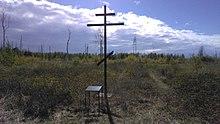| Kursha-2 fire | |
|---|---|
 Memorial | |
| Location | Kursha-2, Ryazan Oblast, RSFSR, USSR |
| Statistics | |
| Date(s) | August 3, 1936 |
| Land use | Mixed, residential and forest |
| Deaths | 1,200 |
Kursha-2 (Russian: Ку́рша-2), named so after a road sign, was an industrial community in the Central Meshchyora, Ryazan Oblast, Russia. It was built soon after the October Revolution for the exploitation of the local forests, and was annihilated by a firestorm on 3 August 1936. The disaster caused 1200 human deaths, making it one of the world's deadliest wildfires.
A narrow-gauge railway ran from the Trans-Meshchyora trunk-railway to Kursha-2 and then extended to Lesomashinny and Charus. More than 1000 lived in this woodcutters' settlement during the 1930s. Trains transported wood to Tumskaya, where it was finished.
At the beginning of August, 1936, a firestorm started near Charus, to the south of Kursha-2. The firestorm extended to the north, growing in intensity to become an aerial or crown fire, a fierce conflagration that consumes fuel from the forest's canopy.
On the night of 2 August, an empty train came to Kursha-2. The train crew offered to evacuate children and women from the settlement, but a dispatcher ordered wood be loaded onto the train. This work hampered a departure, and the firestorm reached the settlement. There weren't enough spaces on the train to evacuate all of the panic-stricken settlers, and hundreds were forced to stay at the station. The escapees sat on the carriage couplings, the steam-engine, and the cargo of the wooden logs. Once departed the train reached a bridge across the canal to the north from Kursha-2. They found it already ablaze. The train was trapped and burnt with almost all passengers aboard including cargo while only a few managed to save themselves.[1]
As the result of the firestorm, 1200 died including woodcutters (some of which were hired from nearby villages), their families, railwaymen, military men, and only twenty escaped, saving themselves in the pond, wells, the channel, and the unforested hill.
The tragedy was intentionally poorly highlighted by Soviet media: only a few brief notes were made public; the only reminder of this event was a common grave near the ruins of the locomotive depot. The settlement was restored, but on a smaller scale. Soon after World War II, it was depopulated, the Kursha-Charus railway was dismantled, and thereafter, only foresters lived in Kursha-2. Now the settlement lies in ruins, and the sole resident of the area, as of 2006, was one 90-year-old woman who survived by escaping from the burning train with the help of another man into flames. Her mother and sisters died the same day.
References
- ^ Смирнова Ю., Волошин В. В 1936 году в СССР от жары и пожаров умирали тысячами. Но об этом никто не знал // Комсомольская правда от 14.08.2010.
- (in Russian) Курша-2: огненный шквал